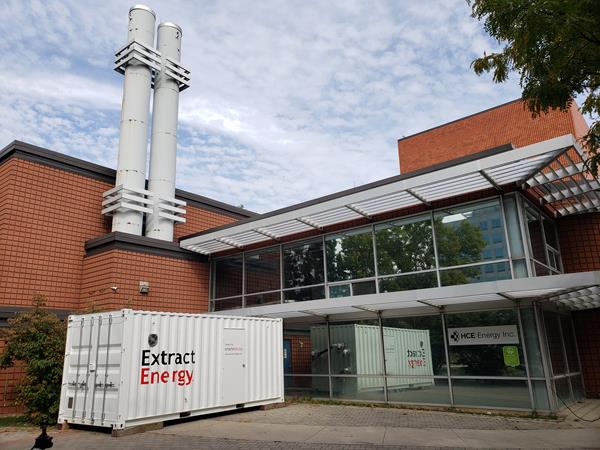Waste Heat-to-Power Capture Pilot Launched in Ontario

Hamilton, a city in Ontario, Canada, will host a pilot project to demonstrate a new technology designed to capture excess hydrothermal energy from its district heating and cooling plant and convert it into grid-quality power.
The pilot hosted by Hamilton Community Enterprises (HCE)-the city's utility solutions arm- will use Extract Energy's Heat Engine," whose core is composed of nickel-titanium (NiTi), a shape memory alloy (SMA) developed by Extract Energy's materials science parent company Smarter Alloys.
 The shape memory alloy-based heat engine converts excess heat from Hamilton Community Enterprises' operation to clean electricity. Courtesy: Extract Energy
The shape memory alloy-based heat engine converts excess heat from Hamilton Community Enterprises' operation to clean electricity. Courtesy: Extract Energy
SMAs are a unique class of alloys that can remember" their shape, even after being bent. The NiTi at the core of the Heat Engine is treated in an innovative and proprietary way" that allows it to be used for extended, repeated activity at lower temperature ranges than other heat engines," Extract Energy explained.
When connected to a facility's waste heat stream, the engine's NiTi core essentially expands and contracts with heat, driving a series of self-actuating valves without any external or internal electrical sources. The cyclical motion is captured by the Heat Engine's generator and converted to usable energy, the company said. And because the engine integrates seamlessly with most equipment, it can be installed in a matter of hours, with no disruption to operations," it said.
The company says its technology generates the highest power conversion commercially available from waste heat between 70C to 150C." Extract Energy installed (in just a few hours) and tested a smaller version of the Heat Engine at Calgary's Last Spike Brewery in 2020. The HCE project will be the first in a series of pilot tests designed to validate the engine's performance on a bigger scale," the company said. The technology was developed with funding and support from Sustainable Development Technology Canada, the Ontario Centre of Innovation, Breakthrough Energy Solutions Canada, and MaR, it noted.
If successful, the technology could be used to extract waste heat energy at virtually any site that continuously generates low-temperature waste heat, such as industrial manufacturing, food processing facilities, energy generation stations, mining operations, combined heat and power plants, or new sources such as data centers and geothermal energy," the company said.
The solution tackles a long-standing problem, the company said. An estimated 65% of the world's energy is rejected as waste heat. Heat generated during industrial and other processes must be rejected to keep materials and equipment cool. The cooling liquid running through these facilities contains sufficient energy called waste heat,'" it said.
A waste heat-to-power market is already flourishing, driven by rising electricity demand, fuel cost concerns, and more stringent regulatory requirements. A recent projection from Valuates Reports suggests the global waste heat-to-power market is estimated to be worth $24 billion in 2022. By 2028, it could grow to $32 billion, the market monitor suggests.
The increasing significance of energy management, rising electricity demand, and huge consumer awareness of the utilization of renewable energy sources will positively impact the market trends. Government initiatives aimed at maximizing energy efficiency are seeing the wide-scale deployment of waste heat to power systems," Valuates Reports said.
According to Extract Energy, however, waste heat capture technologies are today mostly only able to work efficiently within higher temperature ranges-of between 300C and 500C. Some of those technologies also require additional power sources, such as batteries, or even fuel, to perform, the company noted. While technologies like those based on the Organic Rankine Cycle (ORC) offer solutions to convert medium-low grade waste heat into energy, temperatures of medium-low grade heat that ORC systems use most efficiently can still be up to 300C or more. So even with ORC advancements, the majority of waste heat cannot be captured," it added.
Extract Energy's solution looks to capture low-grade waste heat. Ultimately, we're aiming to scale from kilowatts to megawatts of energy," said Extract Energy CEO Ibraheem Khan. Tapping into such an enormous energy source has the potential to save millions of tons of greenhouse gas emissions each year and create the scale of impact that's required to address the climate crisis."
-Sonal Patelis a POWER senior associate editor (@sonalcpatel,@POWERmagazine).
The post Waste Heat-to-Power Capture Pilot Launched in Ontario appeared first on POWER Magazine.